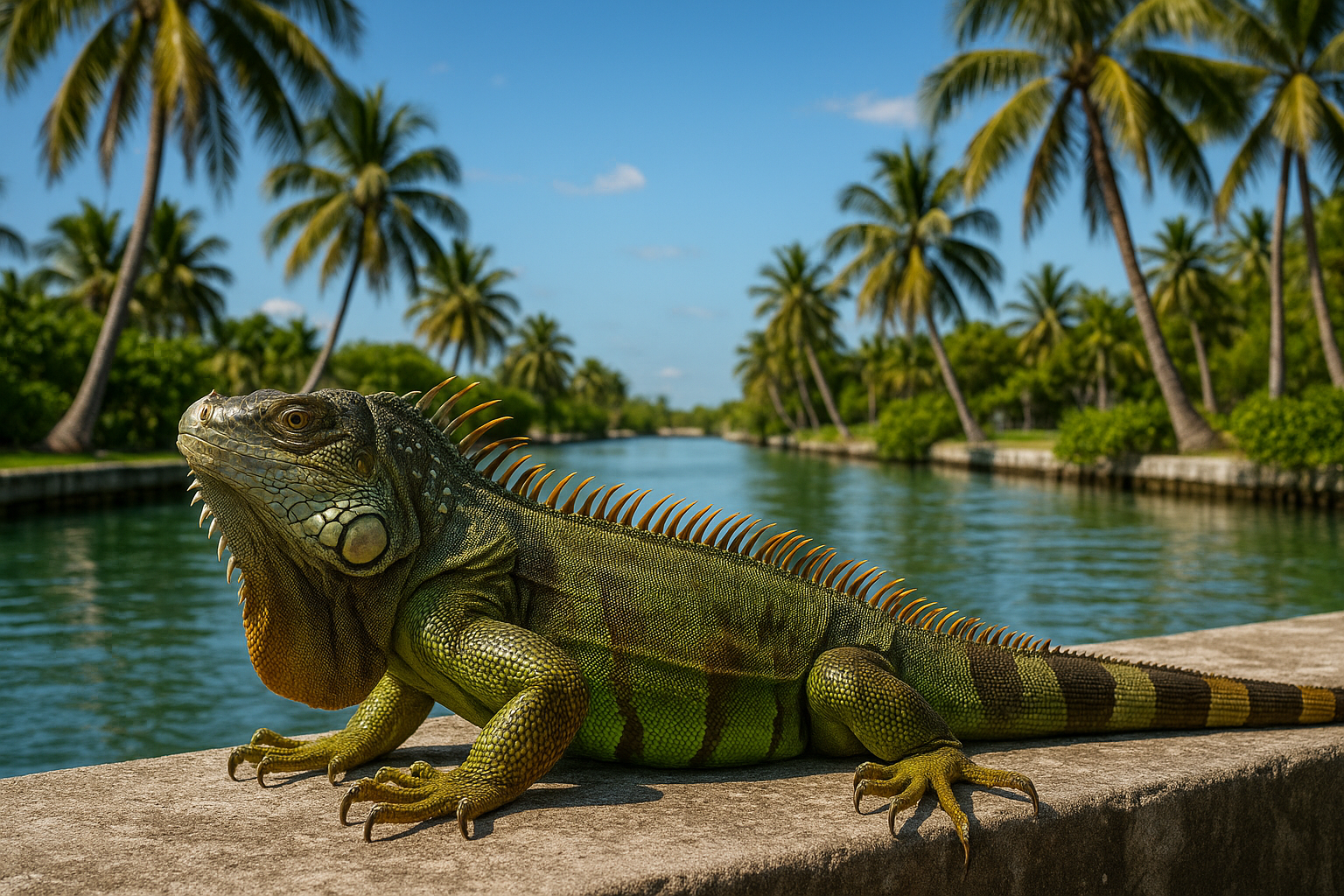Iguanas in Florida: Population, Habitats & Invasive Impact

Iguanas in Florida: Everything You Need to Know About These Invasive Reptiles
Florida's subtropical climate has made it a haven for many exotic species, but none have captured public attention quite like the green iguana. If you've ever wondered "are there iguanas in Florida?" or "do iguanas live in Florida?" the answer is a resounding yes. These large, prehistoric-looking reptiles have established thriving populations throughout the Sunshine State, fundamentally altering local ecosystems and presenting unique challenges for wildlife management. For those interested in seeing them firsthand, you can book a guided iguana hunt in Florida.
The Florida Iguana Population: A Growing Concern
The Florida iguana population has exploded over the past few decades, transforming from occasional escaped pets to a full-blown invasive species crisis. Originally native to Central and South America, these reptiles found Florida's warm climate and abundant food sources ideal for reproduction and survival.
How Many Iguanas Are in Florida?
Determining exactly how many iguanas are in Florida remains challenging for wildlife biologists, but estimates suggest the population numbers in the hundreds of thousands. The Florida Fish and Wildlife Conservation Commission (FWC) reports exponential growth rates, with female iguanas capable of laying 20-70 eggs per clutch and reproducing multiple times per year under ideal conditions. This rapid growth has led to homeowners and visitors seeking iguana hunting experiences in South Florida.
Recent population assessments indicate that South Florida counties host the densest concentrations, with Miami-Dade, Broward, and Palm Beach counties reporting the highest numbers. The lack of natural predators and year-round breeding conditions have allowed populations to flourish unchecked in many areas.
Where Are Iguanas in Florida? Distribution and Habitat Preferences
Understanding where are iguanas in Florida requires examining their preferred habitats and environmental needs. These adaptable reptiles have colonized diverse ecosystems throughout the state, from urban developments to natural preserves.
Primary Distribution Areas
Green iguanas have established populations along Florida's coastlines, particularly in the southeastern regions. The warmest areas of the state provide optimal conditions for year-round activity and reproduction. Major population centers include:
Southeast Florida Corridor: Stretching from Miami-Dade County north to Martin County, this region hosts the state's largest iguana populations. Urban areas like Miami, Fort Lauderdale, and West Palm Beach have become iguana hotspots due to abundant landscaping and minimal predation pressure.
Southwest Florida: Lee, Collier, and Charlotte counties have experienced rapid population growth, with iguanas expanding inland along canal systems and developed areas.
Central Florida Expansion: Orange and Seminole counties now report established populations, indicating the species' continued northward expansion as climate patterns shift.

Where to Find Iguanas in Florida: Prime Habitat Locations
If you're wondering where to find iguanas in Florida, focus on areas that provide the three essentials: basking spots, food sources, and water access. These reptiles are particularly abundant in:
Waterfront Properties: Canals, retention ponds, and waterways provide ideal habitat. Iguanas are excellent swimmers and often use water as escape routes when threatened. Homeowners along South Florida's extensive canal systems frequently encounter these reptiles sunning themselves on seawalls and docks.
Golf Courses and Parks: Manicured landscapes with ornamental plants offer abundant food sources. Many golf courses in Palm Beach and Miami-Dade counties have become unofficial iguana sanctuaries, with some courses reporting hundreds of individuals across their properties. Some even allow guided iguana hunts in Florida as part of wildlife control.
Suburban Neighborhoods: Residential areas with mature vegetation and minimal human disturbance support growing populations. Backyard swimming pools, decorative ponds, and lush landscaping create perfect microhabitats for iguana colonies.

The Big Iguana in Florida: Size and Physical Characteristics
The term "big iguana in Florida" isn't an exaggeration. Adult green iguanas can reach impressive dimensions, with males typically growing larger than females. Understanding their physical characteristics helps with identification and management efforts.
Adult Size Specifications
Male green iguanas in Florida commonly reach 4-6 feet in total length, with exceptional specimens exceeding 7 feet. Their body weight ranges from 8-17 pounds, though well-fed individuals in suburban environments often exceed these averages. The tail comprises roughly two-thirds of their total length, serving as both a swimming aid and defensive weapon.
Female iguanas typically measure 3-5 feet in length and weigh 6-12 pounds. Despite their smaller size, females play crucial roles in population expansion due to their prolific reproductive capabilities.
Distinctive Features
Florida's green iguanas display several identifying characteristics that distinguish them from native reptiles. Their coloration ranges from bright green in juveniles to darker green-brown in adults, with some individuals developing orange or reddish hues during breeding season. A prominent row of spines extends along their back, and dewlaps (throat fans) become more pronounced in mature males.
Ecological Impact on Florida's Native Wildlife
The presence of large iguana populations significantly impacts Florida's native ecosystems. These herbivorous reptiles compete with native species for food resources and nesting sites while also affecting vegetation communities through their feeding habits.
Competition with Native Species
Green iguanas compete directly with several native Florida species, including gopher tortoises, native birds, and smaller reptiles. Their aggressive territorial behavior and efficient resource utilization often displace indigenous wildlife from optimal habitats.
Vegetation Impact
Adult iguanas consume substantial quantities of vegetation daily, preferring flowers, fruits, and tender leaves. In areas with high iguana densities, native plant communities show signs of browsing pressure, potentially altering natural succession patterns and seed dispersal mechanisms.
Climate Factors and Population Growth
Florida's climate plays a crucial role in iguana population dynamics. Unlike their native range, Florida's subtropical environment provides extended breeding seasons and reduces temperature-related mortality.
Temperature Tolerance and Behavior
Green iguanas become lethargic when temperatures drop below 50°F and may experience cold stunning during rare freeze events. However, Florida's mild winters allow year-round activity in most regions, contributing to their population success.
During cooler periods, iguanas congregate in warm microclimates such as concrete structures, south-facing walls, and areas with thermal mass that retain heat. This behavior makes them particularly visible in urban environments during winter months.
Breeding Cycles in Florida
Florida's extended warm seasons allow iguanas to breed earlier and more frequently than in their native habitats. Peak breeding activity occurs from December through April, with females seeking sandy areas for egg deposition. Golf course bunkers, construction sites, and beach areas provide ideal nesting locations.
Management and Control Efforts
Florida wildlife agencies and local governments have implemented various strategies to address growing iguana populations. These efforts range from public education programs to active removal initiatives.
Current Management Strategies
The Florida Fish and Wildlife Conservation Commission encourages homeowners to humanely remove iguanas from their properties. Professional wildlife control services have emerged throughout South Florida, offering removal and exclusion services for residential and commercial properties.
Public Participation
Property owners play crucial roles in iguana management through habitat modification and direct removal efforts. Eliminating food sources, removing shelter options, and maintaining iguana-proof landscaping help reduce local populations.
Living with Florida's Iguana Population
As iguana populations continue to establish themselves throughout Florida, residents must adapt to coexisting with these large reptiles. Understanding their behavior patterns and implementing appropriate management strategies becomes increasingly important for maintaining ecological balance.
Property Protection Measures
Homeowners can implement several strategies to minimize iguana impacts on their properties. Installing physical barriers around vulnerable plants, modifying landscaping to eliminate food sources, and removing basking sites help discourage iguana establishment.
Safety Considerations
While generally non-aggressive toward humans, large iguanas can inflict serious injuries if handled improperly. Their powerful tails, sharp claws, and strong bite require respectful distance and professional handling when removal becomes necessary.
Future Outlook for Florida's Iguana Populations
Population models suggest continued expansion of iguana ranges throughout Florida, particularly as climate change potentially extends suitable habitat northward. Understanding these trends helps wildlife managers and residents prepare for future challenges.
The establishment of iguanas as permanent residents of Florida's wildlife community represents a significant ecological shift. Long-term management will require sustained effort from wildlife agencies, local governments, and private citizens working together to balance ecological health with practical coexistence strategies.
Experience Florida's Wildlife Firsthand
Florida's iguana populations represent just one aspect of the state's diverse and dynamic wildlife communities. From invasive species management to native wildlife conservation, the Sunshine State offers unique opportunities to observe and interact with subtropical ecosystems.
Whether you're interested in wildlife photography, ecological research, or hands-on conservation work, Florida's iguana populations provide fascinating subjects for study and observation. Book a guided iguana hunt in Florida to experience it firsthand and contribute to ongoing management efforts while gaining deeper appreciation for the complex challenges facing Florida's evolving ecosystems.

